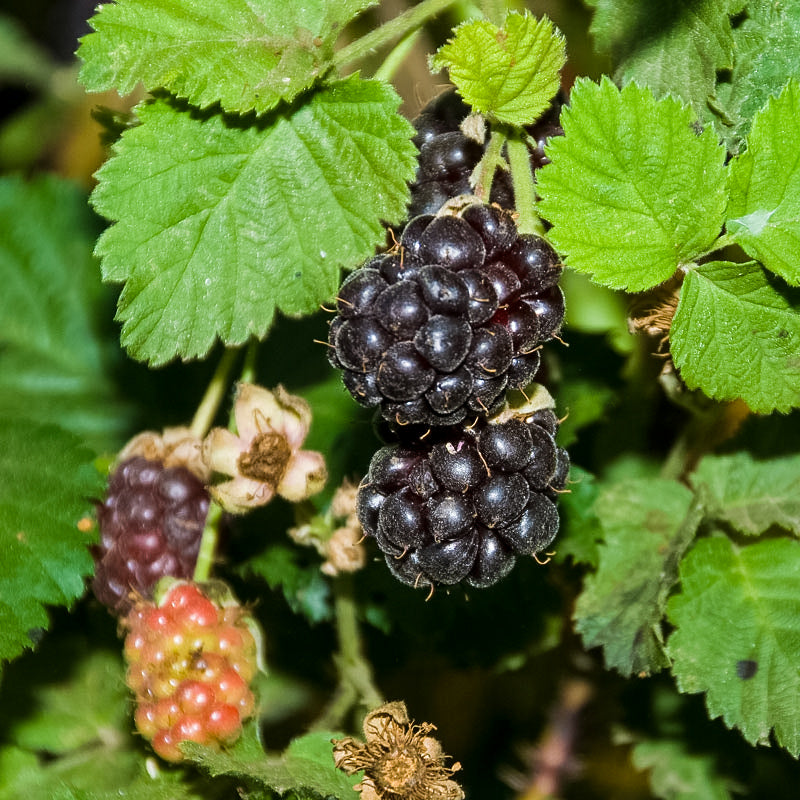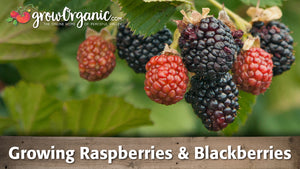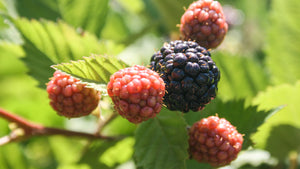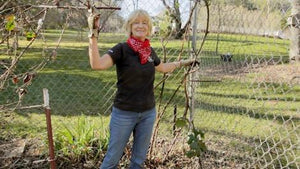Item Number: FV324
Boysenberry
Boysenberry
Bears Large Sweet-Tart Fruit
Zones: 6-9
- Harvest: mid-June to early July
- Fruit: Large, long fruits that ripen to a deep maroon. Juicy, sweet-tart berry with delightful aroma.
- Facts of note: Perfect for freezing, canning, jams, jellies, and eating fresh. Boysenberries were developed from European raspberries and three different varieties of native blackberry. Needs protection below 10°F. Boysenberries are the fruit that made Knott's Berry Farm of Buena Park, California famous.
- Plants are 2 year, grade #1Boysenberries
Esteemed for their large, sweet-tart fruit, thrive within specific parameters that cater to their growth and fruitfulness. Delving into the nuances of cultivating these berries reveals a process that requires attention to detail and a grasp of their unique needs.
Understanding the Basics:
Boysenberries, scientifically known as Rubus ursinus, are ideally suited for Zones 6-9. Bearing fruits from mid-June to early July, these berries boast elongated shapes and mature to a rich maroon hue. Their flavor is a delightful blend of sweetness and tartness, accompanied by an inviting aroma.
Origins and Development:
Rudolph Boysen, George Darrow, and Farmer Walter Knott play significant roles in the history of boysenberries. This fruit resulted from the crossbreeding of European raspberries and three distinct varieties of native blackberries. Farmer Walter Knott's cultivation of boysenberries at Knott's Berry Farm in Buena Park, California, contributed greatly to their popularity.
Ideal Conditions:
Boysenberries demand careful attention to their environmental needs. They flourish in well-draining soil and require protection when temperatures drop below 10°F. Full sun exposure aids their growth, although they also appreciate some shade in scorching climates. Adequate air circulation is crucial to prevent fungal diseases.
Planting and Care:
Planting two-year-old, grade #1 boysenberry plants sets a solid foundation for growth. Ensure proper spacing, usually 4-6 feet apart, allowing the plants ample room to spread and thrive. Regular watering is essential, especially during dry spells, while mulching helps retain moisture and regulate soil temperature.
Pruning and Maintenance:
Pruning is pivotal for boysenberries. Removing dead or diseased canes and keeping the growth controlled ensures better fruit production. Prune during the dormant season, and be cautious, as they bear fruit on second-year canes.
Pollination:
Boysenberries are self-pollinating, though additional nearby plants can enhance pollination and fruit set. Encouraging pollinator-friendly flora in the vicinity can attract beneficial insects and aid in the pollination process.
Harvest and Usage:
Harvest boysenberries when they reach full ripeness, displaying their deep maroon color and easily detaching from the vine. Their versatility allows for various culinary uses, including freezing, canning, making jams, jellies, or simply relishing them fresh. Proper storage in the refrigerator prolongs their shelf life.
Boysenberries stand as a testament to meticulous cultivation, offering a delectable fruit known for its versatility and unique flavor profile. By providing them with the right conditions and care, growers can enjoy bountiful harvests and relish the fruits of their labor.
For more information, please enjoy our Growing Guide for planting and growing cane berries.


Check Your Zone Compatibility:
Compatible with your zone.
Growing Zone for
,

Our Guarantee To You
Since 1976, we've served our customers at every stage of growing. Please contact us at any time. We are happy to support and assist you.
Description
Description
Zones: 6-9
- Harvest: mid-June to early July
- Fruit: Large, long fruits that ripen to a deep maroon. Juicy, sweet-tart berry with delightful aroma.
- Facts of note: Perfect for freezing, canning, jams, jellies, and eating fresh. Boysenberries were developed from European raspberries and three different varieties of native blackberry. Needs protection below 10°F. Boysenberries are the fruit that made Knott's Berry Farm of Buena Park, California famous.
- Plants are 2 year, grade #1Boysenberries
Esteemed for their large, sweet-tart fruit, thrive within specific parameters that cater to their growth and fruitfulness. Delving into the nuances of cultivating these berries reveals a process that requires attention to detail and a grasp of their unique needs.
Understanding the Basics:
Boysenberries, scientifically known as Rubus ursinus, are ideally suited for Zones 6-9. Bearing fruits from mid-June to early July, these berries boast elongated shapes and mature to a rich maroon hue. Their flavor is a delightful blend of sweetness and tartness, accompanied by an inviting aroma.
Origins and Development:
Rudolph Boysen, George Darrow, and Farmer Walter Knott play significant roles in the history of boysenberries. This fruit resulted from the crossbreeding of European raspberries and three distinct varieties of native blackberries. Farmer Walter Knott's cultivation of boysenberries at Knott's Berry Farm in Buena Park, California, contributed greatly to their popularity.
Ideal Conditions:
Boysenberries demand careful attention to their environmental needs. They flourish in well-draining soil and require protection when temperatures drop below 10°F. Full sun exposure aids their growth, although they also appreciate some shade in scorching climates. Adequate air circulation is crucial to prevent fungal diseases.
Planting and Care:
Planting two-year-old, grade #1 boysenberry plants sets a solid foundation for growth. Ensure proper spacing, usually 4-6 feet apart, allowing the plants ample room to spread and thrive. Regular watering is essential, especially during dry spells, while mulching helps retain moisture and regulate soil temperature.
Pruning and Maintenance:
Pruning is pivotal for boysenberries. Removing dead or diseased canes and keeping the growth controlled ensures better fruit production. Prune during the dormant season, and be cautious, as they bear fruit on second-year canes.
Pollination:
Boysenberries are self-pollinating, though additional nearby plants can enhance pollination and fruit set. Encouraging pollinator-friendly flora in the vicinity can attract beneficial insects and aid in the pollination process.
Harvest and Usage:
Harvest boysenberries when they reach full ripeness, displaying their deep maroon color and easily detaching from the vine. Their versatility allows for various culinary uses, including freezing, canning, making jams, jellies, or simply relishing them fresh. Proper storage in the refrigerator prolongs their shelf life.
Boysenberries stand as a testament to meticulous cultivation, offering a delectable fruit known for its versatility and unique flavor profile. By providing them with the right conditions and care, growers can enjoy bountiful harvests and relish the fruits of their labor.
For more information, please enjoy our Growing Guide for planting and growing cane berries.
About Boysenberries: Boysenberry vines prefer deep, well–drained, fertile soil. Boysenberries bear fruit on 2–year old wood. These brambles thrive in most soil types but they do not tolerate poor drainage. Boysenberries are versatile and hardy but are not as cold hardy as other brambles. Plant late winter to early spring. Space 4–6’ in a row with 6–8’ between rows. Sold by the individual plant.
Shipping Information
Shipping Information
Cannot ship to the following states: HI, AK, PR, GU, VI
Cannot ship via USPS.
Cannot ship via SmartPost.
Shipping Weight: 2.0 lb
Dimensions: 16.0"L x 3.0"W x 3.0"H
Features
Features
- Grow on a Trellis
- Self-fruitful
- Suited to Warmer Climates
Characteristics
Characteristics
Planting & Care
Planting & Care
Useful Information
Useful Information
Guarantee
Guarantee
Limited Dormant Tree & Plant Guarantee
* Claim deadline is June 15th
We guarantee that your dormant tree or plant will arrive in good, viable condition. If your tree arrives in substandard condition, notify us within 3 days of delivery. Please email pictures of the box, inside packaging, the tree and its roots to helpdesk@groworganic.com. We will investigate your claim and process a request to exchange or refund the damaged product.
If your dormant tree or plant has not grown new leaves by June 15th, you may be eligible for our Limited Dormant Tree & Plant Guarantee. This guarantee provides for a store credit for the purchase price of the tree, excluding shipping. Please see the Instructions below.
Important Dates:
- April 1st Dormant trees/plants must be planted in the ground
- May 15th Perform scratch test, if no new leaves have grown
- June 15th Deadline to apply for a dormant tree/plant credit
All required documentation must be received by June 15th for your claim to be considered. Claims or documentation received after June 15th will be denied, without exception. Instructions listed below
Terms and Conditions
We cannot guarantee that your tree or plant will remain alive and healthy after it is received, or bear fruit as there are too many variables in your environment that are beyond our control (i.e. soil preparation, weed and pest control, proper irrigation, chill hours, compatible hardiness for your growing zone, proper choice of pollinator, extreme weather, rodent damage, disease, etc.).
We cannot guarantee that we will be able to provide a replacement tree/plant of the same species either that same growing season or in future years. Customers are responsible for all shipping fees associated with replacement trees and plants.
If we determine that the tree you purchased directly from us is not viable, we will issue you a store credit (not a refund) for the purchase price of the affected dormant tree or plant. Shipping is not included in the dormant tree/plant guarantee. Store credits can be used to purchase any product we sell and are valid for use only until July 1st of the following year.
Historically, 98% of our dormant trees and plants grow and thrive when they have been cared for and planted using our growing guides. Dormant trees and plants must be planted in the ground by April 1st in order to be eligible for credit. If the ground in your area is still frozen solid, you may temporarily plant your tree or plant in a pot.
Potted, non-dormant trees or plants are excluded from this guarantee as they are not dormant at the time of shipment. Evergreen trees such as citrus, avocado and olive trees are not available for credit under the Dormant Tree and Plant Guarantee.
Instructions
We guarantee that your dormant fruit tree or plant will leaf out, if you care for it according to our growing guides. In the unlikely event that your dormant tree or plant does not have leaves by May 15th, follow these simple steps to apply for a store credit:
Before you call or email, please perform a “scratch test” to determine if the tree or plant is still alive. This video shows how to check for live tissue under the bark. Scratch tests need to be done a few inches above and below the graft.
Green Cambium Layer / Living Trees
If the cambium layer under the bark is green, give your tree a little more time. It is still alive, but hasn’t come out of dormancy yet. Check to make sure that it is getting the right amount of deep root water, enough sunlight and that the weather is warm enough for that type of tree/plant to come out of dormancy. Every tree has its own personality and will come out of dormancy at different times. Be sure to submit the required documentation listed below by June 15th, if it doesn’t grow leaves.
Brown Cambium Layer / Dead Trees
If the scratch test shows a brown cambium layer or if your dormant tree/plant doesn’t have leaves by June 1st, please email us at helpdesk@groworganic.com. All required documentation listed below must be received by June 15th for your claim to be considered. To be considered for the guarantee claim, all required documentation must be received by June 15th. Incomplete submissions will be denied.
Required Documentation
- Order number
- Name of dormant tree/plant and the quantity affected
- Photos of each tree or plant showing:
- The roots (tree or plant must be pulled out of the ground)
- The scratch test areas
- The entire tree/plant
We reserve the right to not issue credit for items that have already been replaced. We also reserve the right to require photographic evidence that the tree/plant was not killed by root rot, rodent or mechanical damage.
Share
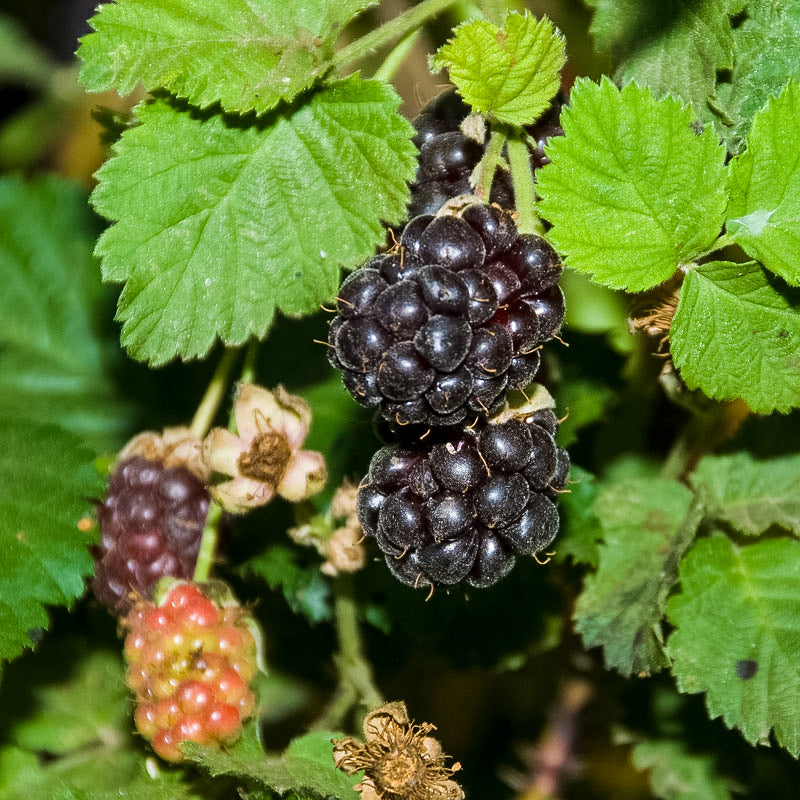
I bought a one boysenberry bare root plant and an very happy with my purchase. At first I was not sure if it would grow as it was just a 🌱 stick and know oh my it's so big and getting bushieee🤭 can't wait to taste the fruit. What a great addition to our backyard.. 😊
Bought 50 thrones boysenberry plants, great price! Never before had such complete instructions on acclimating the plants! Doing a slow-acclimation now with a root-stimulator diluted B1 vitamin mix to adjust to the warming Southern Orange County climate. Great job Peaceful Valley!
Received these a week ago with lots of new growth already started. I've tried ordering bareroot berry plants in the past & they never made it. These on the other hand are acting like nothing ever happened to them. Can't wait for them to start producing fruit.
Boysenberries produced abundantly without any pests or problems. They seem to be a no fuss no muss berry. Delicious flavor - very sweet and juicy.
I planted 4 of these in early 2010 in Escondido, CA. Only 2 survived, but both produced well in their second year. I had forgotten that the fruit matures in June, so it was a pleasant surprise! Like most cane berries, the time period between slightly tart and overripe is only 3-4 days, so you'll want to keep a close eye out. I used bird tape for about 3 weeks and it was fairly effective.

